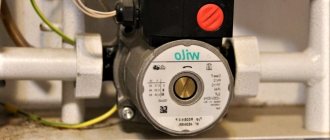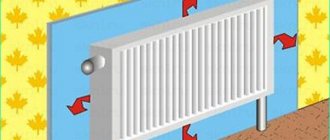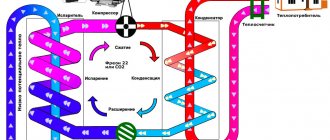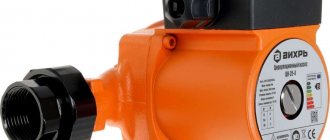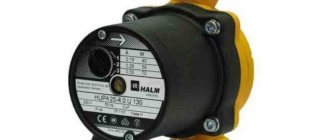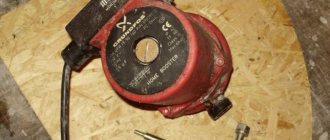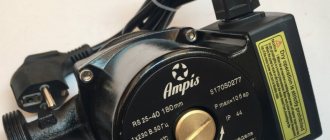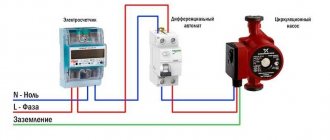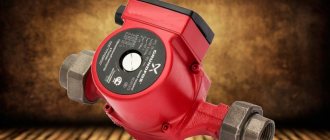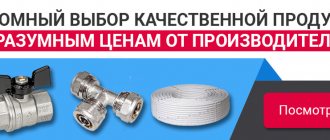SHARE ON SOCIAL NETWORKS
FacebookTwitterOkGoogle+PinterestVk
A water pump for heating is a device that is used to increase the efficiency of autonomous heating systems for private houses, as well as cottages. Such a device affects the movement of the coolant, which occurs continuously. Today there are many varieties of such circulation pumps. To select a suitable device, you need to familiarize yourself with its operating principle, as well as technical characteristics.
The water pump helps increase the efficiency of autonomous heating systems
Operating principle and technical characteristics of circulation pumps for heating systems
A pump of this type is a device within which a motor and a working shaft are located. Its main function is to pump working fluid. The popularity of such devices in autonomous heating structures is due to the fact that they allow the building to be heated more efficiently.
Using a circulation pump in a heating system allows you to reduce the cost of heating rooms
The operating principle of the circulation pump is quite simple. When it starts, the rotor begins to act on the impeller (rotate it). Due to this, a reduced pressure is created at the inlet, and, on the contrary, an increased pressure at the outlet. The speed of movement of the working fluid through communications increases, which reduces the financial costs of heating a private home.
Helpful information! A similar device operates from a regular electrical network, the voltage of which is 220 V. The power of the device depends on its type, as well as on what mode is used during its operation. This figure varies from 25 to 100 W/h.
In many models, you can select a speed mode, which is selected individually, depending on the technical characteristics of the autonomous heating communication. And also circulation pumps for water supply are equipped with a certain marking, which indicates the main characteristics of the device.
Most models of circulation pumps are equipped with the ability to select a speed mode, which is selected depending on the technical characteristics of the heating communication
Energy requirement
In addition, there is another parameter that needs to be taken into account, albeit indirectly. This is the building's need for heat. The value of this parameter is indicated in the building’s passport during the design process. If this data is not available, then it is easy to calculate it yourself.
Each country has its own heat standards per 1 m2. According to European standards, heating 1 m2 of a one- or two-apartment house will require 100 W and 70 W for an apartment building. Russian standards are established for each specific region in accordance with the requirements of SNiP.
Advantages of circulation pumps for heating systems
Previously, the installation of heating communications in private homes did not include the installation of pumping equipment. The working medium in such systems moved through the pipes by gravity. Today, some cheap solid fuel boilers are made without integrated pumps. This can be explained quite simply - the company that produces the boilers does not know the parameters of the heating circuit. For such designs, it is recommended to purchase a circulation pump device.
There are several advantages of installing a pump in the heating system of a private home. For example, the load on the heating boiler is reduced by equalizing the temperatures in the incoming and outgoing pipes. Another advantage of the circulation pump is that it ensures uniform heating of the rooms due to the same temperature of the working environment at any point of the heating ring.
Layout of the water pump in the heating system
And also when installing such a device, it becomes possible to quickly regulate the temperature of the coolant in the heating pipes. It is also worth saying that when starting an autonomous heating structure, the boiler warms up much faster if such a pump is integrated into the system.
The operating principle of circulation pumps eliminates the need to position the pipe at a certain slope to the boiler. It also becomes possible to use thinner pipes in communications. This not only saves space, but also reduces the cost of the heating structure as a whole.
Of the disadvantages of this device, only one can be identified - dependence on the electrical network. If there are frequent interruptions in the network, then using the device will be difficult. However, this problem can be dealt with quite simply by installing an uninterruptible power supply (UPS).
The use of a circulation pump eliminates the need to place pipes at a certain slope to the boiler
Summary
The positive effect of using circulation pumps is obvious to users of autonomous heating systems.
Thanks to them, a higher degree of comfort in the premises is ensured. It manifests itself in the emergence of a number of new possibilities: - maintaining a given temperature in each individual room; - reducing the difference in temperatures between the heated coolant leaving the boiler and the cooled coolant returning to the boiler. Thanks to this, there is a noticeable increase in the service life of the heating device; — installation of pipes in the system that have a relatively small diameter; — practical elimination of coolant losses due to evaporation, characteristic of open systems.
Types of circulation pumps for heating private houses
Today, all models of such devices are classified according to the principle of operation into two types:
- "dry";
- "wet".
Many people are interested in the question of which circulation pump to choose for installation in a private home. “Dry” type devices are more voluminous in size and include an engine compartment extended to the side. Such models are rarely installed in residential buildings. This is due to the fact that during operation they make quite a lot of noise. However, such devices have high efficiency - up to 80%.
Design of a heating communications system for a residential building
Note! “Dry” type devices require careful maintenance. This is due to the fact that their sealing elements wear out very quickly and need to be replaced on time.
As a rule, such devices are installed in separate extensions due to their noise. The operational area of “dry” type pumps is heating points, which are characterized by high power. They can also be used in autonomous heating communications that require maximum performance. In private homes, such devices are practically not installed.
Features of “wet” pumps for heating in a private house
Wet type devices are much more compact and versatile. Their installation is carried out by inserting into the pipeline structure, in contrast to “dry” devices that require cantilever installation. And they also do not require the organization of an additional cooling system, since excess heat is transferred to the working environment that passes through them.
Installation of the “wet” type of pump is carried out by inserting into the pipeline structure
The performance of “wet” type circulation pumps is lower. This is due to the fact that the rotor operates in a liquid working environment, which provides a certain resistance. Therefore, the efficiency of “wet” pumps ranges from 50 to 60%. Nevertheless, the use of such equipment is considered the most optimal in conditions of autonomous heating systems.
The characteristics of circulation pumps of this type allow them to be installed even in living rooms. During operation they make virtually no noise. It is also worth saying that the low performance of these devices fully pays off, since their operation requires much less electrical energy.
The power of small models used in private homes is approximately 25-50 watts, which is comparable to the energy consumed by a regular light bulb. It’s also worth saying that circulation pumps for heating (12 Volt) are perfect for small private houses.
Wet-type circulation pumps do not require special maintenance
The service life of a “wet” circulation pump can be several decades (with normal use). Such devices are easy to maintain and do not require preventive maintenance.
Thus, these products are ideal for home use. Another advantage of these pumps is their design. It includes separate modules (assemblies) that can be easily replaced if necessary.
Units with a “wet” rotor
In this case, the rotor also does not have direct contact with the pumped liquid. But the design feature allows the rotor to be supported in the mechanism due to special metal or ceramic seals made in the form of rings. It is precisely the presence of these o-rings that protect the mechanism from the direct impact of liquid on the rotor. The principle of operation is as follows: a barely noticeable, very thin layer of liquid appears between two o-rings rubbing against each other. It is the presence of this layer that ensures the maintenance of the required pressure difference in the working chamber of the pump. At the same time, during operation of the equipment, the rings are strongly compressed to each other, this factor ensures even greater tightness of the pump. Cooling and lubrication of the engine, in this embodiment, occurs due to the liquid that passes through the working cavity of the unit. This type of circulation pump has a number of advantages over pumps with a dry rotor. It is practically silent, has a modest weight and small dimensions, does not require constant presence during long-term operation, and is energy efficient.
Naturally, circulation pumps with a “wet” rotor are the most popular when installing autonomous heating. The undisputed leader on the Russian market is pumps from the Dutch company Grundfos. Let's use its line as an example to look at the main functions that circulation pumps have today.
A company with many years of experience in the production of equipment for heating systems presents pumps in the new Alpha line. These models replaced the already known pumps of the UPS line.
Heating circulation pumps Grundfos
Pumps from this brand are the most popular in the modern heating equipment market. Depending on control capabilities and design features, all Grundfos products are divided into:
- unregulated (UPS series);
- adjustable (ALPHA series).
Grundfos circulation pump disassembled
Models of the “UPS” series are the most popular among domestic consumers. The operational scope of such devices is open or closed autonomous heating communication of a private house.
Helpful information! In some cases, Grundfos UPS pumps are used in small production facilities.
The popularity of Grundfos circulation pumps is also due to the fact that they are affordable and of high quality. Today they are produced in the following countries: Germany, Denmark, China.
When selecting a pump online in an online store, you may encounter models that differ in their technical characteristics. Let's look at the types of Grundfos UPS devices that can be purchased via the Internet:
- UPS 25-40/60/80;
- UPS 32-40/60/80.
The technical characteristics of water pumps (depending on the model) allow you to raise the height of the working medium by 4, 6 or 8 m
The numbers indicated in the model name indicate its installation characteristics. The first number indicates the cross-sectional area of the pump union nuts, which are made in most cases from cast iron material. In some cases, there are nuts with a diameter of 40 mm, however, most often products with cross-sectional indicators of 25 and 32 mm are used.
The second number corresponds to the height. Depending on the type of device, the height of the working medium column can be 4, 6 or 8 m.
Related article:
Heating options for a country house: choosing a boiler
Selecting a boiler based on power and type of fuel. Advantages, disadvantages, features and price of solid fuel, gas, electric units.
These figures will help answer the question that arises for many owners of private houses: how to choose a circulation pump for heating. Therefore, under no circumstances should they be ignored. The price of Grundfos UPS circulation pumps ranges from 4,000 to 40,000 rubles, depending on the model and technical equipment.
There is a marking on the pump body indicating its installation characteristics.
Which is better to buy a circulation pump for heating a private house: ALPHA series
The adjustable line of pumps from is represented by three main models, which belong to the same series (ALPHA). Let's look at the types of these devices, depending on their functionality:
- ALPHA2 L;
- ALPHA2;
- ALPHA3.
ALPHA2 L. Grundfos heating pumps in this series have limited functionality and have 7 operating modes. It is worth saying that ALPHA2 L can be used in heating structures such as heated floors. It includes a system that allows you to regulate the coolant pressure in the communication. Air removal from the ALPHA2 L circulation pump is carried out by “pushing”, which distinguishes it from the UPS series devices. Selecting the required mode is quite simple - by pressing a button on the control unit.
The circulation pump model ALPHA2 is compatible with most modern solid fuel boilers
ALPHA2. Pumps of this type have 9 operating modes and are more versatile from an operational point of view. It is also worth saying that such devices include two additional functions that allow you to customize the device depending on the season and time of day. Thanks to this, there is an opportunity for additional financial savings. ALPHA2 pumps are compatible with almost all modern solid fuel boilers.
Helpful information! The cost of pumps in this series ranges from 6,000 to 25,000 rubles.
Separately, it is worth mentioning that the circulation pump for heating Grundfos ALPHA2 has another mode called AUTOADAPT. It allows you to automatically change the operating parameters of the device, depending on the changing seasons. Thus, the pressure in the system is regulated through a complex computational process that occurs continuously.
The ALPHA3 pump model is equipped with a special unit that allows you to transfer data on the operation of the circulation device to a smartphone
ALPHA3. This device is an improved model of the previous circulation pump. The main difference between ALPHA3 and ALPHA2 is that owners can independently adjust the pressure indicator in the heating communication.
When selecting a Grundfos pump, it is recommended to pay attention to the fact that the ALPHA3 model is equipped with a special unit called ALPHA Reader. This device allows you to transfer data about the operation of the circulation device to a smartphone. To use this function, you will need to download a special program (GRUNDFOS Go Balance) to your mobile device.
Cost of different types of pumps
There are many companies on the market specializing in the production of circulation units. Consumers are advised to buy models from reputable European manufacturers. The products of some Russian enterprises are also in demand.
| Model | Manufacturer country | price, rub. |
| Prima UPS 25/60 180 | Russia | 1570 |
| Wester WCP 25-40G | Russia | 2127 |
| LRP 32-50/180 | China | 2598 |
| Hoffmann UPC 25-40 180 | Germany | 5256 |
| Yonos PICO 15/1-4 | Germany | 6051 |
| A 56/180 XM | Italy | 10953 |
You can find both budget and expensive models on sale. Which pump to buy for a heating boiler is an individual decision for the home owner. When choosing, some are guided by the level of popularity of the manufacturer, others - by cost, and still others - by the availability of the service. Learn how to choose a heating radiator by following the link.
Heating circulation pumps Wilo
Pumps from the Vilo brand are also very popular among consumers. This equipment is produced in Germany and is distinguished by high quality and long service life. The design of Vilo devices takes into account the presence of a “wet” rotor, and their operating principle is based on direct contact of the impeller with the coolant. The price range of Wilo devices is quite wide (from 4,000 to 55,000 rubles).
Wilo circulation pump disassembled
Today there are 4 main series of Wilo circulation pumps:
- STAR;
- TOP;
- STRATOS;
- YONOS.
WILO STAR. Devices of this series are usually used in autonomous heating communications of private houses with a small area. Such devices are very popular because they are affordable. There are two types of circulation pumps "VILO STAR": RS, RSD.
As for, it is capable of providing the necessary pressure in a standard heating system. The technical characteristics of the WILO STAR heating circulation pump allow you to maintain the required pressure in the communication, which has an area of up to 750 m².
Overall dimensions of the circulation pump Wilo Star-RS 25/6
The dimensions of the STAR series device are compact, which is also an important advantage. The installation length of the device is 18 cm, and the weight ranges from 3 to 5 kg.
WILO TOP. Such circulation devices are used for installation in heating structures that have an area of up to 1400 m². A special feature of this equipment is that it is equipped with heat-insulating material. Thus, VILO TOP pumps can be installed not only indoors, but also outside. Such devices are designed to work in communications, the pressure in which is from 6 to 10 bar (atmospheres).
Separately, it is worth mentioning that WILO TOP devices have a flange design. There are several improved models of the “TOP” series, which have the following markings: RL, S, Z. WILO TOP circulation pumps are often used in enterprises and are resistant to aggressive environments.
Three-dimensional design of a heating system for a country house
WILO STRATOS. This series of devices appeared relatively recently. VILO STRATOS circulation pumps feature an electronic control system and are used in heating structures with an area exceeding 1400 m². They are compatible with modern boilers with a power rating of 25 kW or more.
Note! The performance of WILO STRATOS devices has been increased compared to previous models and reaches 16 bar. They are excellent for energy-saving heating communications.
WILO YONOS. One of the latest series from Wilo. Such circulation pumps include an electronic control unit, as well as the function of eliminating solid particles from the working environment of the heating communication.
The installation process of circulation pumps is quite simple and can be handled without the involvement of specialists
How to choose a circulation pump for heating: tips
Many people are interested in the question of how to choose a circulation pump for heating. To select this product for a specific heating system, you need to pay attention to several factors. Most of these devices are visually similar to each other, however, they can differ greatly in their technical characteristics.
For private use, choose devices that operate on a standard network with a voltage of 220 V. A very important parameter is the power of the device. It depends on two main factors: the model and the mode in which the pump operates. Household appliances have a power rating that does not exceed 50-70 watts.
Experts also recommend paying attention to the temperature of the coolant. All household circulation pumps have restrictions on this indicator and can be used in heating systems with temperatures up to 110°C.
Most pump models are installed on pipes using union nuts
How to choose a circulation pump for heating, focusing on geometric parameters? From the point of view of geometric parameters, the installation length of the device plays an important role, as well as the cross-sectional indicator of the threaded part of the device. Most pumps are installed on pipes using union nuts, which are also called American nuts. As a rule, such elements are included with the device. Standard cross-sectional indicators that apply to home heating circuits are 25 and 32 mm. And the installation length of the device can be 13 or 18 cm.
Among other things, it is worth paying attention to the markings that are applied to the pump housing. The protection class of the electrical device is often indicated there, as well as the maximum outlet pressure. The first parameter is standard for most modern models and is designated IP44. The maximum outlet pressure in most cases is 10 bar.
An important factor when choosing a pump is the size of the installation length of the device
If necessary, you can always consult with a specialist who will help you choose the appropriate device for your heating structure. You can also ask a question that interests you on one of the specialized forums on the Internet.
How to choose a circulation pump for heating, depending on performance
Another important parameter that should be considered when choosing this equipment is its performance. This indicator indicates the amount of working medium that the device is capable of pumping in a certain unit of time (m³/hour). It is also worth considering the amount of pressure that the pump is capable of creating, calculated in meters.
In most cases, the main technical characteristics of such devices are indicated in their name. For example, if you look at the name of the device “Grundfos UPS 32-80”, then the first two digits mean the diameter of the pipes (32 mm), and the second – the pressure value, which is 8 m.
Note! When choosing the necessary device, you should definitely calculate it for a specific heating system. This will allow you to purchase the most suitable circulation device.
Heating diagram for a house with a floor-standing boiler, weather-compensating automation and a boiler: 1 - boiler; 2 — set of safety devices; 3 - boiler; 4 — boiler safety group 3/4″ 7 bar; 5 — hydraulic accumulator 12l/10 bar; 6 - pump; 7 - 3-circuit manifold; 8 — bracket with fastening kit; 9 — connection kit to the boiler (1.0 and 1.2 m); 10 — straight module; 11 — mixing module with electric drive; 12 - KTZ-20 Du 20; 13 — valve 11B27P Du 20; 14 — valve KEG 9720 Du 20 (220 V); 15 — signaling device; 16 — gas meter; 17 — expansion tank 35 l/3 bar; 18 — make-up valve; 19 — fine cartridge filter 1″; 20 - water meter; 21 — filter with manual washing 1″; 22 — ball valve for water; 23 — polyphosphate dispenser
The selection of a circulation pump for a heating system must be approached as competently as possible. Therefore, it is worth considering even such points as the condition of the premises and the characteristics of the climatic region in which you live. If your house has good thermal insulation, then it is enough to get by with a device with low power (and vice versa).
You also need to take into account the dependence of the pump power on the climatic region. In this case, the following pattern can be traced: the colder the climate of the area in which the residential building is located, the more powerful the circulation device is needed. If necessary, specialists in specialized stores can help you answer the question of how to choose a circulation pump for heating.
What to look for when choosing a pump?
The selection of a separate pump for the heating circuit must take into account many parameters.
Equipment technical parameters
Circulation equipment has a number of characteristics that are especially important to consider when purchasing.
These include:
- Efficiency is the ratio of the volume of electricity consumed to the useful work performed on pumping the coolant.
- Pressure is the difference in pressure between the outlet and inlet ports of the pump.
- Water supply is the maximum volume of coolant pumped through the working chamber with minimum resistance of the heating circuit.
- power .
- Pipe diameter is the nominal value of the connected equipment.
- The maximum nominal pressure (indicated by PN) in the operating circuit at 20 °C, at which the long-term operation of the device is still guaranteed within the warranty period.
This data is usually sufficient to confirm that the technical characteristics of the pump meet the parameters of the heating system.
We examined the selection criteria in more detail in this article.
Sufficient power of the device
The choice of a specific model of circulation equipment is influenced by technical characteristics, as well as the financial capabilities of the buyer and the properties of the heating system. If you want to save money, it is important that the pump power is sufficient for normal operation of the boiler. After all, the water supply level indicated in the instructions is always significantly higher than the actual one.
To independently determine the adequacy of the device’s power, three stages of calculations must be carried out.
Stage #1 - determine the pump performance
Determining the required pump performance using the formula.
The required thermal heating power greatly depends on the material of the walls, the presence of gaps in the floor and the tightness of the window frames
For apartments in multi-storey buildings, the heating thermal power is assumed to be 75-80 W/sq. m., for houses - 100-120 W/sq. m. The temperature difference at the boiler inlet and outlet is usually 10 °C.
It turns out that for an apartment of 60 square meters. m. the actual pump performance of (80*60)/(1.16*10)=414 (l/hour) will be sufficient.
Stage #2 - calculate the pressure value
Determining the amount of pressure to overcome the total hydraulic resistance of the system using the formula.
Each shut-off valve has its own hydraulic resistance indicator, which is determined using special tables. When calculating, the resistance values of all pipeline elements are taken into account
This formula requires complex calculations using reference data, so for home and apartment heating systems you can use a simplified schedule.
The pressure loss strongly depends on the diameter of the pipes, so when choosing between two possible sizes, it is better to choose the larger one
According to the schedule, the pressure loss in an apartment with a pipe diameter of 20 mm will be 70 mm/m, and taking into account the pipeline length of 50 m - 3.5 meters. This figure should be multiplied by a factor of 1.3-2.2, which takes into account the resistance of the water pressure fittings.
Stage #3 - determine the pump power
Determining the sufficiency of pump power according to the graph of pressure-flow characteristics.
Insufficient power of the water pump leads to excessive gas consumption in the boiler and can even lead to fatal breakdowns
This schedule is indicated in the operating instructions, and it is unique for each pump model. If the intersection point of the parameters calculated above is below curve B, then the device is suitable for the heating system, but if above, then not.
We provided detailed recommendations for calculating a circulation pump with specific examples in the following article.
Additional functions of the device
If constant fluid movement is critical for the heating system, then you can install a pair of pumps located in series in the circuit. The second motor in such a system can be turned on if there is insufficient power or failure of the first motor.
To automate the operation of a boiler with heating from a heating circuit, you can use pumps with a thermostat and timer. The built-in mechanism ensures that the engine is turned on and off depending on the coolant temperature and time of day.
The terminal box may have adjustment knobs and an indicator panel. LCD displays on heating pumps are rarely used due to high temperature intolerance
In branched heating networks, circulation pumps with a thermostat and continuously adjustable impeller speed can be used. With their help, the speed of the coolant is independently regulated in different loops, depending on its temperature. Pumps with automation are many times more expensive and are rarely used in apartments and small residential buildings.
The market offers both models with standard and non-standard structures that provide additional functionality. We have provided the rating of the best heating pumps, based on reviews from real users, here.
Other nuances of choosing a pump
It is important that the equipment not only performs its function, but also works for a long time, without causing inconvenience to the residents of the house or apartment.
Therefore, when choosing a device, you should adhere to the following rules:
- Choose well-known pump manufacturers: Calpeda, Grundfos, WILO. The price of their equipment is 20-40% more, but the likelihood of breakdown is much less.
- Take a device with characteristics that are 20-30% higher than calculated. This reserve will reduce the operational load and increase the service life of the equipment.
- Pay attention to the dimensions so that the pump fits in the space provided for it.
- The operation of the device should be as silent as possible so as not to disturb residents at night.
- There is no need to strive to buy a model with a power that greatly exceeds the calculated parameters. This will only lead to excessive energy consumption, but also to unnecessary noise.
- Choose a pump specifically for heating systems, because they are designed for operating temperatures up to 130-150 °C.
- It is desirable that the device have a built-in mesh to filter solid particles suspended in the coolant.
The performance characteristics of the equipment must necessarily correspond to the parameters of the heating system; it is impossible to save on this. Additionally, you will only have to pay for a reliable manufacturer, increased security of the housing and an automatic control system.
Most household heating circulation devices do not require adjustment. To start them, it is enough to connect the pipes to the pipeline and connect the device to the electrical network. We looked at how to properly install the pump in step-by-step instructions.
Features of calculating a circulation pump for a heating system
Calculating power is a very important operation that is necessary when choosing a water pump. If you buy a device that is too powerful, the water in the communication will make noise, and if you buy a device with a small performance index, then the house will warm up unevenly.
When choosing a suitable circulation pump, two parameters should be taken into account - engine performance and supply pressure.
To buy a circulation pump for a heating system (specific), in fact, you need to calculate only two parameters: engine performance and the amount of supply pressure.
The operating power of the circulation pump comes from the overall thermal performance of the heating structure. It follows from this that the device must pump a volume of coolant in such a quantity that it is enough to heat all the radiators in a residential building. Calculating the operating power of a device is an individual procedure, since each home requires a different amount of resources.
There are two popular ways to determine the operating power of a water pump:
- using an online calculator;
- through formulas.
In the first case, you need to find the appropriate online calculator on the Internet using the search bar of your browser. The second method allows you to calculate power more accurately. Let's consider the formula by which this indicator can be determined:
X = 3600U (A x B) , where:
U – heat costs required to heat a certain area of the house; A is the thermal conductivity index of water, which is 4.187 kJ/kg; B – temperature difference between the supply and return lines. In most cases, this figure is 10-20 °C.
If difficulties arise when calculating the operating power of the pump, you should consult a specialist or use an online calculator
Helpful information! For installation on a heating circuit in private houses with an area of 100 m², a device with an operating power of 10 kW is sufficient. Thus, at least 1 kW of power is required per 10 m².
The characteristics of the heating circulation pump, indicated on its body, can also help in determining the operating power.
Pump device
The main elements that make up the circulation pump are:
- housing made of stainless steel, bronze, cast iron or aluminum;
- rotor shaft and rotor;
- wheel with blades or impeller;
- engine.
Typically, an impeller is a structure of two parallel disks that are connected to each other by means of radially curved blades. One of the disks has a hole for liquid to flow through. The second disk secures the impeller to the motor shaft. The coolant passing through the engine acts as a lubricant and coolant for the rotor shaft where the impeller is fixed.
Since the engine stator is energized, it is separated from the rotor using a glass made of stainless steel or carbon material. The walls of the glass are 0.3 mm thick. The rotor is fixed on ceramic or graphite bearings for sliding.
Water pump for heating: installation
The correct installation of the water pump determines how well it will perform its functions, as well as the efficiency of the heating communication in general. There are several basic recommendations that should be followed when carrying out installation work.
How to properly install a heating circulation pump? Installation of such equipment on the heating circuit is carried out only after shutting off the water in it. It is very important to remember that the rotor axis of the device must be horizontal. Installation of this element in a vertical plane is strictly prohibited. It is also recommended to install a filter in front of the circulation device, which is necessary to catch solid foreign elements of the working environment.
It is optimal to install the circulation pump in a heated floor system on the supply pipe
If you plan to install a circulation pump in a heated floor heating system, then it is necessary to place it at the correct point in the circuit. The most suitable option is installation on the supply pipe. This is due to the fact that the risk of air locks in it is minimized.
You should also not forget about sealing the connections, which is done using a special FUM tape. After installation of the equipment, it is necessary to check its functionality. To do this, a test run is performed, however, before this, care must be taken to remove air from the system.
Upon completion of installation, it is necessary to check the functionality of the equipment
Knowing how to properly install a heating pump, you can save a lot, since such work is not cheap to have professionals do. But if you do not have confidence in your own abilities, then it is better to use the services of a master.
